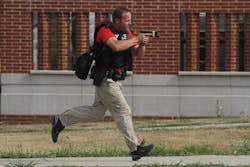Active Shooter Response Continues to Evolve
If you take a look back at the active shooter response movement—now over twenty years old—it’s easy to see the timeline of response evolution, policy adjustment, etc. Some agencies seem to have a hard time keeping up with the times. The unconscionably slow response at Marjory Stoneman Douglas High School is an example of how an agency’s training and policies fell behind the times. The single officer (school resource officer) response at Great Mills High School is an example of a more contemporary response.
The challenge we have in law enforcement is that we sometimes get so caught up in the evolution of tactics development that we don’t slow down enough to ask ourselves a couple of very valid questions. Is this change necessary? Is this change beneficial? Is this change universal or are there mitigating circumstances?
Very seldom will we develop a specific response protocol that has universal application with no impacting circumstance(s). It’s rare that we develop a tactic that is used “100% of the time without fail.” Too much is unknown. Too much is unexpected. Too often we have to improvise, adapt and overcome unforeseen challenges. And none of that takes into consideration the fact that circumstances change as the situation develops. Nothing stays as it was at the onset and our own response can impact how a dynamic situation flows.Some things about active shooter response are non-specific enough to never change:
- We should get on scene as fast as is safely possible (if you don’t get there, you can’t do any good, so responding in an unsafe manner is just stupid).
- We should arm/equip ourselves as best we can with what we have available.
- We should respond to the sound of shots/scene of the on-going threat; engage and neutralize the threat in the most time efficient manner possible.
Where some things have changed for response protocol is in manpower where it’s an option. (We’ll explain “where it’s an option” farther down). In the beginning of Active Shooter Response (ASR), the most common response protocol was to arrive quickly, team up to form the four-man diamond, move to the shots and neutralize the threat. The concept of a four-man diamond didn’t fly in some places because they simply didn’t have the manpower or the response distance was potentially so great that by the time four officers got on scene, the shooter would have died of old age. OK...that’s an exaggeration, but not by much. Some jurisdictions simply don’t have the density of manpower to provide such response.
As an adjustment to that reality, many agencies started training buddy teams: two officer response teams. That improved things some, but didn’t resolve all challenges; and it didn’t answer one question that was frequently asked:
If I’m the first officer there and I can go in to engage the one shooter, thereby saving lives and minimizing injuries, how can I morally, professionally and ethically justify waiting for another officer?
Since there was no good answer to that and since risk is inherent to the job, the single officer response couldn’t really be denied as a potential response protocol. The reality is that not every officer has the courage to do it. The large majority do. Where an agency felt it was a viable option, the protocol was developed and trained. The faster an officer got on scene to engage the gunman (or gunmen), the faster the threat to innocents could be either redirected to the officer or neutralized outright.
There is no arguing that this single officer response protocol is in the best interest of protecting innocent life. There is also no arguing that it creates a greater risk for the responding officer. With all that in mind, let’s look at a hypothetical situation and then discuss it.
Situation: An active shooter call goes out. Officers respond. The first officer on the scene is at his trunk pulling on his plate carrier/kit and grabbing his rifle. As he is doing so, a second officer pulls up and exits his vehicle. The first officer is kitted up and ready to go and shouts, “Catch up to me when you can!” and sprints into the school/location. The second officer is behind him… by about five to ten seconds. Just as the second officer is going in, the third and fourth officer pull up with more not far behind them.
Discussion: Should the first officer have waited the brief period of time...that five to ten seconds...for the second officer to be ready so that they could make entry as a buddy team rather than two single officers?
Single officer response protocols say go when ready; no waiting. Officer survival protocols say to always have backup when you can/if it’s available. The question then becomes whether or not the five- to 10-second delay is acceptable. Understand as you read the rest of this that there is no fixed/correct yes or no answer.
Five to 10 seconds...it seems such a brief period of time. Everyone can hold their breath that long. Most NFL players can run half to a full football field length in that time. On the range, five to ten seconds means three to five well aimed shots.
Now think about those three sentences. One indicates how short that time frame is. The other two indicate how much can be accomplished in that “brief” period of time. If you’ve ever been in a fight for your life, you know just how long five to ten seconds can be. The unfortunate reality is that an active shooter can easily engage two, three, four or more victims in that five to ten seconds. It’s just a matter of how fast he can shoot and how accurate he is (thankfully most of them aren’t). So while the first officer on scene waits five to ten seconds for the second officer to be ready, even though he’s already there and kitting up as fast as he can, that small passage of time can mean increased victims; increased casualties.
That’s the balance and trade off we always need to keep in mind as we make the decision. And rest assured: NO ONE can make that decision except the officer who has to make it. It will be different, or can be, at every active shooter scene and there will be a myriad of circumstances the officer has to consider before he makes that decision. Many people will second guess him and, no matter which way he goes with that decision, there’s always the chance someone will file a civil suit against him for having made the wrong decision.
At the end of the day, whether or not it was the right decision will be determined by how at peace the officer is in his soul and how easily he sleeps at night. Almost every officer knows what it feels like to regret a decision and, much to the media’s disbelief, the decisions involving innocent life are always the ones that haunt us most.
The decision won’t be easy when you have to make it. Make it easier by maintaining your training, maintaining your equipment and making sure the simple repetitive stuff is as it always should be: ready to go. That will free up your mind to make the tougher decisions you will face. Do the best you can do because that’s all anyone can ever ask of you, but more importantly, it’s what will bring you peace of mind after the fact. If you did your best, the regrets are minimized and the self-criticism can go away.

Lt. Frank Borelli (ret), Editorial Director | Editorial Director
Lt. Frank Borelli is the Editorial Director for the Officer Media Group. Frank brings 20+ years of writing and editing experience in addition to 40 years of law enforcement operations, administration and training experience to the team.
Frank has had numerous books published which are available on Amazon.com, BarnesAndNoble.com, and other major retail outlets.
If you have any comments or questions, you can contact him via email at [email protected].




